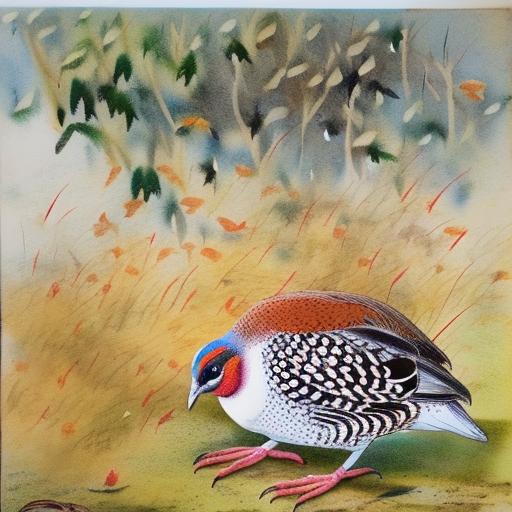Indian quail breeding has gained popularity in recent years due to the high demand for quail meat and eggs. Quails are small birds that are relatively easy to care for and can be raised in small spaces, making them an ideal choice for small-scale farmers and backyard breeders. The Indian quail, also known as the Japanese quail, is the most commonly raised species for commercial production due to its fast growth rate and high egg production.
Quail breeding can be a profitable venture for those who are willing to invest time and effort into creating the ideal breeding environment, selecting the right breeding stock, and understanding quail breeding behavior. With the right knowledge and resources, breeders can successfully raise healthy quails and produce a steady supply of meat and eggs for the market. In this article, we will explore the key aspects of Indian quail breeding, from selecting the right breeding stock to caring for quail chicks, and provide valuable tips for successful breeding.
Key Takeaways
- Indian quail breeding is a lucrative business opportunity with the right knowledge and resources.
- Selecting the right breeding stock is crucial for successful quail breeding.
- Creating the ideal breeding environment involves providing proper housing, temperature, and lighting for the quails.
- Understanding quail breeding behavior is essential for successful breeding and egg production.
- Managing quail breeding challenges such as disease, aggression, and egg production issues is important for a successful breeding operation.
- Caring for quail chicks involves providing proper nutrition, warmth, and protection from predators.
- Tips for successful Indian quail breeding include regular health checks, proper sanitation, and record-keeping for breeding performance evaluation.
Selecting the Right Breeding Stock
Selecting the right breeding stock is crucial for successful quail breeding. When choosing breeding stock, it is important to select birds that are healthy, have good conformation, and exhibit desirable traits such as high egg production and fast growth rate. It is also important to avoid inbreeding by selecting unrelated birds to prevent genetic abnormalities and ensure the overall health and vigor of the offspring.
When selecting breeding stock, breeders should also consider the age and reproductive history of the birds. Young, healthy birds that have not been overbred are ideal candidates for breeding. Additionally, it is important to consider the genetic diversity of the breeding stock to maintain a healthy and robust gene pool. By carefully selecting the right breeding stock, breeders can improve the overall quality of their quail flock and ensure a successful breeding program.
Creating the Ideal Breeding Environment
Creating the ideal breeding environment is essential for successful quail breeding. Quails are sensitive birds that require a clean, well-ventilated, and stress-free environment to thrive and reproduce. The breeding environment should include appropriate housing, nesting areas, feeding and watering systems, and adequate space for the birds to move around and exhibit natural behaviors.
Quails can be housed in cages or aviaries, depending on the scale of the breeding operation. The housing should provide protection from predators, extreme weather conditions, and disease transmission. Nesting areas should be provided to encourage natural mating behavior and egg laying. Additionally, a well-balanced diet and access to clean water are essential for maintaining the health and reproductive performance of the breeding stock.
Maintaining a clean and hygienic environment is also crucial for preventing disease outbreaks and ensuring the overall well-being of the quails. Regular cleaning and disinfection of the breeding environment, as well as proper waste management, are important practices for creating a healthy and productive breeding environment.
Understanding Quail Breeding Behavior
Understanding quail breeding behavior is essential for successful reproduction and egg production. Quails are social birds that exhibit complex mating behaviors, including courtship displays, vocalizations, and territorial interactions. Male quails perform elaborate courtship displays to attract females, while females select mates based on their displays and physical condition.
Quails are prolific layers, with females capable of laying up to 300 eggs per year under optimal conditions. Understanding the natural egg-laying behavior of quails is important for providing appropriate nesting areas and collecting eggs for incubation. Additionally, understanding the incubation behavior of quails is important for successfully hatching eggs and raising healthy chicks.
By observing and understanding quail breeding behavior, breeders can create an environment that supports natural mating and egg-laying behaviors, leading to higher reproductive success and increased egg production.
Managing Quail Breeding Challenges
Quail breeding comes with its own set of challenges that breeders must be prepared to manage. One common challenge in quail breeding is maintaining optimal environmental conditions, including temperature, humidity, and lighting, to support reproductive performance. Fluctuations in environmental conditions can negatively impact egg production and hatchability.
Another challenge in quail breeding is managing aggressive behavior among males during mating season. Male quails can become territorial and aggressive towards each other, leading to injuries and reduced reproductive success. Providing adequate space and visual barriers within the breeding environment can help reduce aggressive behavior among males.
Disease management is also a significant challenge in quail breeding. Quails are susceptible to various diseases and parasites that can impact their health and reproductive performance. Implementing biosecurity measures, regular health checks, and vaccination programs can help prevent disease outbreaks and maintain a healthy quail flock.
By proactively managing these challenges, breeders can minimize potential risks and ensure a successful quail breeding program.
Caring for Quail Chicks

Caring for quail chicks is a critical aspect of quail breeding that requires attention to detail and proper management practices. Quail chicks are delicate and require a warm, clean, and safe environment to thrive. Providing a brooding area with appropriate heat sources, such as heat lamps or brooders, is essential for maintaining the body temperature of the chicks during their early days.
Quail chicks should also be provided with a balanced diet that meets their nutritional requirements for growth and development. High-quality chick starter feed with added vitamins and minerals is recommended for supporting healthy growth and immune function. Additionally, access to clean water is essential for keeping the chicks hydrated and promoting proper digestion.
Regular monitoring of the chicks’ health and behavior is important for identifying any potential issues early on. Common health issues in quail chicks include dehydration, nutritional deficiencies, and respiratory infections. By providing attentive care and addressing any health concerns promptly, breeders can ensure the overall well-being of the quail chicks and promote their healthy growth.
Tips for Successful Indian Quail Breeding
Successful Indian quail breeding requires careful planning, attention to detail, and proactive management practices. To ensure a successful breeding program, breeders should focus on selecting high-quality breeding stock with desirable traits such as high egg production and fast growth rate. Avoiding inbreeding and maintaining genetic diversity within the breeding stock is also important for producing healthy offspring.
Creating an ideal breeding environment that supports natural mating behaviors, egg production, and incubation is essential for reproductive success. Providing a clean, well-ventilated housing with appropriate nesting areas, feeding systems, and access to clean water is crucial for maintaining the health and productivity of the quails.
Understanding quail breeding behavior, managing breeding challenges, and providing attentive care for quail chicks are key aspects of successful quail breeding. By observing natural mating behaviors, managing environmental conditions, preventing disease outbreaks, and providing proper care for quail chicks, breeders can ensure a healthy and productive quail flock.
In conclusion, Indian quail breeding offers a rewarding opportunity for farmers and breeders to produce high-quality meat and eggs for the market. By following best practices in selecting breeding stock, creating an ideal breeding environment, understanding quail breeding behavior, managing challenges, caring for quail chicks, and implementing proactive management practices, breeders can achieve success in Indian quail breeding.
If you’re interested in learning more about the breeding and care of poultry, you might also want to check out an article on PoultryWizard.com that discusses the incubation period for goose eggs. This informative piece provides valuable insights into the process of hatching and raising geese, which can be a fascinating complement to your knowledge of Indian quail breeding. You can find the article here.
FAQs
What is Indian quail breeding?
Indian quail breeding refers to the process of raising and breeding quails, specifically the Indian quail species, for various purposes such as meat and egg production.
What are the benefits of Indian quail breeding?
Indian quail breeding offers several benefits, including high meat and egg production, low space and feed requirements, and quick maturity and reproduction rates.
What are the key considerations for Indian quail breeding?
Key considerations for Indian quail breeding include providing proper housing, nutrition, and environmental conditions, as well as disease prevention and management.
What are the common challenges in Indian quail breeding?
Common challenges in Indian quail breeding include maintaining optimal breeding conditions, managing diseases and parasites, and ensuring proper egg incubation and chick rearing.
What are the potential markets for Indian quail products?
Indian quail products, such as meat and eggs, have a growing market demand due to their nutritional value and unique flavor. Markets include local consumers, restaurants, and specialty food retailers.
Meet Walter, the feathered-friend fanatic of Florida! Nestled in the sunshine state, Walter struts through life with his feathered companions, clucking his way to happiness. With a coop that’s fancier than a five-star hotel, he’s the Don Juan of the chicken world. When he’s not teaching his hens to do the cha-cha, you’ll find him in a heated debate with his prized rooster, Sir Clucks-a-Lot. Walter’s poultry passion is no yolk; he’s the sunny-side-up guy you never knew you needed in your flock of friends!







